#enneacanthus
Explore tagged Tumblr posts
Text

Blue-spotted Sunfish (Enneacanthus gloriosus), family Centrarchidae, order Perciformes, Delmarva Peninsula of the Mid-Atlantic U.S.
This individual was caught as part of a scientific survey, and then released.
photograph by Austin Kaplan
#sunfish#enneacanthus#centrarchidae#perciformes#fish#bony fish#ichthyology#animals#nature#north america
177 notes
·
View notes
Text
Sunshine for the cooler water aquarium
Enneacanthus gloriosus, the blue-spotted sunfish, is not related to the pelagic molid sinfishes, but is part of a Nearctic clade also named sunfishes, the centrarchids. Its length approaches 10 centimeters, or 4 inches, whereas other centrarchids species may be much larger. The maximum size of E. gloriosus, it should be noted, seems to vary between wild populations, being only 6 centimeters, or less than 2 and a 1/2 inches, in the Mississippi. This sunfish is native to the Atlantic and Gulf Slope drainages of North America, from New York State and Pennsylvania, to the south of Florida. Within this range, E. glorious is found mainly in richly vegetated oxbows and side ponds, the presence of vegetation being imperative for E. glorious to forage food. More broadly the species is found in other freshwater habitats, with sandy or muddy bottoms, and vegetation, such as Elodea, Crinum, Sagittarius, and Myriophyllum. Such habitats may be darkly stained and turbid. E. gloriosus feeds primarily on copepods, cladocerans, ostracods, and chironomid fly larvae.
E. gloriosus can experience high summer tempertures over parts of its range, as high as 29 or 30 degrees centigrade, though 23 to 27 degrees is probably a closer estimate, of the optimum for their aquarium welfare. Naturally, being native to seasonal climates, the winters are much cooler, and a winter season might be simulated for these animals, by dropping the temperature down to 10 degrees, or a little less, without which they will not breed. The range of pH preferred by E. gloriosus in the wild, is reported to be 4 to 7, or acidic to neutral. Most populations probably come from waters, with a pH of 5.6 to 6.5. Certainly, Enneacanthus sp. exhibit reduced growth when breeding in water below a pH of 4.5, and in any case, it is difficult for the aquarist to maintain a stable aquarium environment, with a pH below 5. In the aquarium, these are peaceful fishes, that should not be housed with aggressive species. They should be fed on defrosted foods, that are appropriate to their wild diet.
0 notes
Text
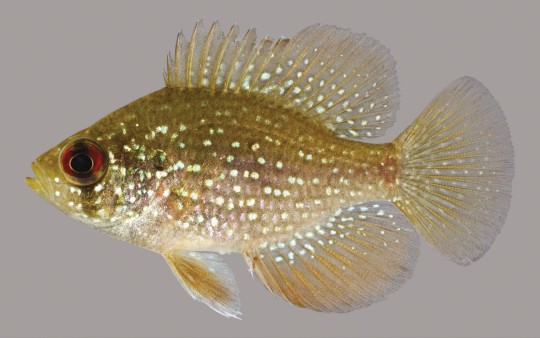
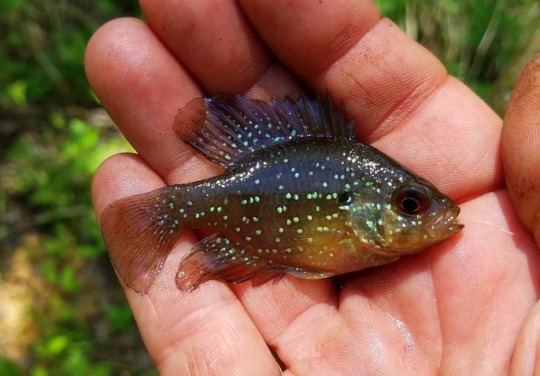
Blue-spotted sunfish | Enneacanthus gloriosus
x, x
375 notes
·
View notes
Text
VA Native Fish Hunting - 25

What a great day for some fishing! This is one of my favorite spots to spend a half hour knee-deep in swamp muck. Really, can't recommend it enough. Nothing new per se today but a couple of really neat finds.
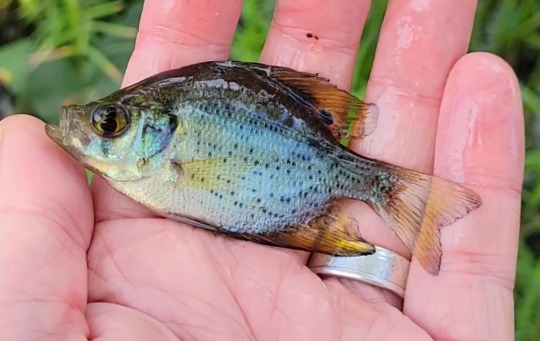
Let's start on a high note. My very first search landed me this GORGEOUS Flier (Centrarchus macropterus). I hadn't caught any in close to 3 years, and even those were just tiny inch long fry. This beaut was much larger and extremely impressive. I would like to one day have some in my 125 gallon tank, but since that's not free today, back he went.
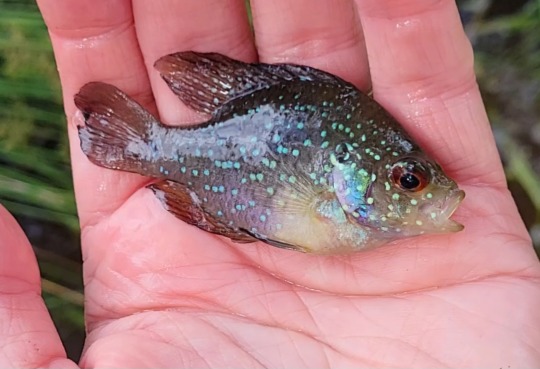
The next fish I caught was this Bluespotted Sunfish (Enneacanthus gloriosus). I love this fishing spot specifically because I can find these here, and in fact I caught maybe 5 BSSs today. Beautiful animals and highly recommend them for home keeping - definitely some of my favorite native fish!

This little guy is not as straightforward as the last two. It's a Lepomis spp but it could be a few different species. With the wavy body lines, I would guess Warmouth, but could also possibly be Pumkpinseed or Bluegill. Regardless, it was a neat find today as I don't see many Lepomis here often.

These Eastern Mosquitofish (Gambusia holkbrooki) are what I came for today actually. I used to have a dozen in my 55 gallon tank but they only live for about 2 years and I'm down to my last 4. So I caught 8 more, including 3 males. I personally like them but they get kind of a bad rap regarding aggression in my opinion.

We also get a fair amount of crayfish in this area! Again, I'm not that knowledgeable about them, but I'm pretty sure it's a Cambarus spp. - maybe C. bartonii. Those seem to be common in my neck of the woods anyways.
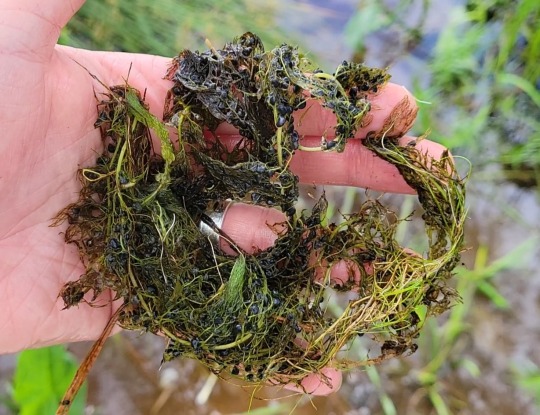
The most common submerged plant here were these bladderworts - also a very fun inclusion for home tanks. They are carnivorous plants but do perfectly well without being fed live animals. The only real caveat is that they don't seem to like extended stays under direct light.

The other common plant here was this Spatterdock (Nuphar advena) which has spread quite a bit since I was last here earlier in the year. Much too big for home or pond usage honestly, but neat plants all the same.
41 notes
·
View notes
Text
youtube
This episode focuses on a piece of private property that had been frequented - with permission from the landowner - for decades by botanists, birders, and other naturalists from the region. This piece of land was destroyed last week in order to make way for the border fence, destroying two federally listed endangered plant species, as well as hundreds of "old growth" Peyote plants. This piece of property was one of the most intact crumbs of remaining wildplant and animal habitat in a region that is slowly getting smothered with garbage retail development, car-dependent sprawl and McMansions. The property in question was a private ranch that the state bought (for likely far too little) to build the border wall after the federal government temporarily put a halt to the project on private property. The landowner told us he basically had to sell or suffer an eventual eminent domain possession. He seemed numb. This property had been in his family for at least a hundred years. A friend who's studying rare plants here came out during the afternoon heat to show us where some things were that we missed. Ernesto & I had been here three weeks ago to scope it as well. All these plants (Hamatocactus hamatacanthus, Echinocereus poselgeri, Ancistrocactus scheeri, etc) will be transplanted to a new home in the ground on private property a few miles away where they will be safe and protected, but the state should've been doing this and funding it. Instead it was all volunteers. Botanists & native plant people from the region have been coming here for the past two weeks to rescue plants, like Coryphantha macromeris, Echinocereus poselgeri, Echinocereus enneacanthus, Homalocephala texensis, Thelocactus bicolor, Physaria thamnophila (federally listed), Ancistrocactus scheerii, Hechtia glomerata, Mammillaria sphaerica, Mammillaria prolifera, Escobaria emskoetteriana,Hibiscus martianus and even a few Asclepias prostrata (also federally listed) that were in the direct path of the 200 ft wide by miles-long swath that is going to be cut. Sadly, there was so much that couldn't be saved.
5 notes
·
View notes
Photo

Cockerel wrasse (Pteragogus enneacanthus) at Komba Island in Indonesia
Francois Libert
221 notes
·
View notes
Video
Black-banded Sunfish - Enneacanthus chaetodon by HGHjim
0 notes
Photo

Texas Native Plant Lab / Dallas Arboretum Another round of Echinocereus enneacanthus, green strawberry hedgehog cactus, blooms are stunning us this week.
#texas native plant lab#dallas arboretum#Echinocereus enneacanthus#cactus#succulent#worklife#hedgehog cactus
78 notes
·
View notes
Text
Produzione fiorale e fruttifera su Echinocereus enneacanthus in seguito a trattamenti con silicio
Valutazione vegetativa e radicalelunghezza e numero di spineproduzione fiorale e durata in vasoproduzione di fruttinumero di semi per frutto #silicio #cactus #echinocereus #ornamentale #frutti #fiori

View On WordPress
0 notes
Photo

Domino has become my most photogenic fish. Still shy mostly. I really want to upgrade his space though.
49 notes
·
View notes
Text
Blue spotted sunfish
The blue spotted sunfish is quite possibly the most beautiful of Northern freshwater fishes. Even it’s scientific name, Enneacanthus gloriosus portrays this. I’ve found this fish in slow-flowing rivers and narrow lakes in both perfectly clear and nearly opaquely dark waters. I just love this fish so much!



43 notes
·
View notes
Photo

Echinocereus enneacanthus
The flowers of Echinocereus enneacanthus look quite similar to those of Echinocereus viereckii, with their vivid magenta petals and pale yellow centers, but E. enneacanthus is a spinier plant with smaller stems. It comes from northern Mexico and northward into Texas and New Mexico. The flowers are not long-lasting, but they certainly make an impression!
-Brian
62 notes
·
View notes
Text
VA Native Fish Hunting - 20

So apparently I started recording my fish hunts two years ago this month and it seems appropriate that I hit a neat milestone in entry number 20 (not counting interludes)! And as kind of a neat coincidence, I had an eventful hunt with a few new species to share! Hope you enjoy :)

The tide was high today and the beach was gone (frown!) so I was unclear what luck I'd actually have hunting fishes. I've been to this location before and had a good idea of what I was likely to find here. What I had not found before were Bluespotted Sunfish (Enneacanthus gloriosus) here! This little guy was dead and floating right at my start point - both a good sign and a bummer at the same time. What I thought was neat was this sunfish, unlike literally every other one I had found in VA, was in a basic pH river rather than an acidic bog. Makes me wonder what little offshoots I can explore with a kayak.

Another fish I haven't found here were Banded Killifish (Fundulus diaphanus) like this beautiful fellow above! Among my favorite NANFs for home keeping (or in general), this guy was iridescent gold and blue, bright breeding colors for this species. I let him go - hopefully the ladies will appreciate his "near death encounter" with a massive beast (i.e. me) and living to tell the tale!
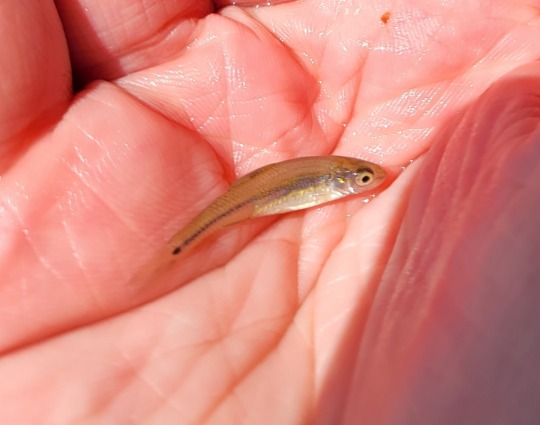
Last time I came here, the most plentiful fish I caught, by far (like, 50-to-1) were Eastern Mosquitofish. This time? The most common catch were these Spottail Shiners (Notropis hudsonius), one of our small native minnows. Though they max out at 6 inches, 3 inches is much more common, and most of what I caught were about 1 to 1.5 inches. Probably only hatched earlier this year.
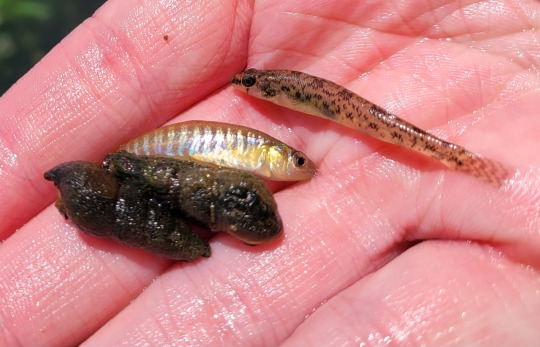
One net swipe here! A couple of fish, a couple of snails. Who can argue?
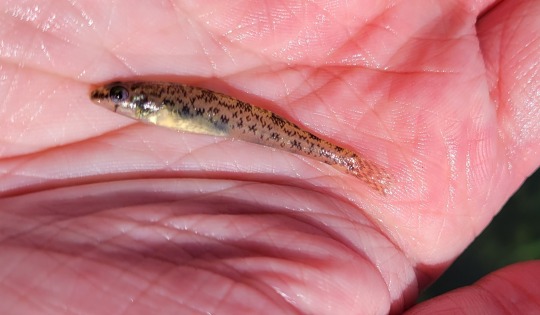
I caught maybe 3 or 4 of these Tesselated Darters (Etheostoma olmstedi) at this location - I love love LOVE the two I have in my tank at home and wouldn't mind more at some point, but I wasn't looking to keep any fish today, so they got to swim back home. But let me reiterate that anybody who keeps a North American biotope tank would do well to look into the Etheostoma genus of Darters!
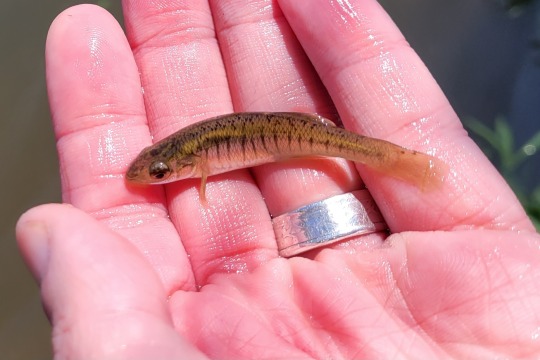
It took me a few swipes to finally catch a female Banded Killifish, which as you can see do look significantly different from the breeding colored males. Still great aquarium fish for sure.

Though I only saw a handful of live ones, I saw a ton of shells for these Chinese Mystery Snails (Cipangopaludina chinensis), an invasive critter that has overpopulated in the area. How exactly one shell got wedged (very hard by the way!) into another shell is beyond me.

As I was swiping my net, I felt a crawling up my arm that gave me the willies (tick season does that to me) but very pleasantly it was NOT a tick and was instead this Blue Dasher (Pachydiplax longipennis). He was trying to dry his wings out it seemed - probably recently emerged - and was very happy to pose for some pictures. I set him on a tree stem and he went upon his way.
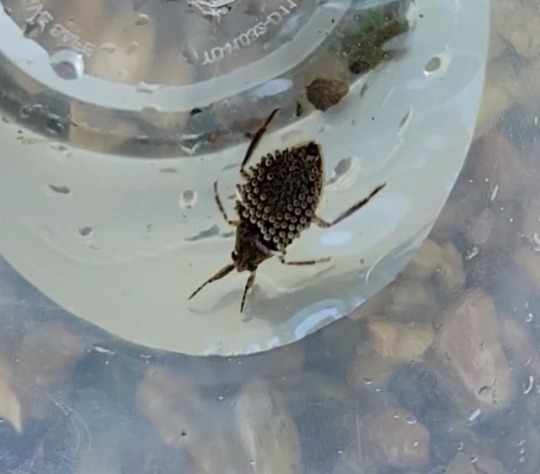
Another first for me was this Toebiter (Belostoma flumineum), carrying eggs on its back! Very cool animal, but given their terrible bite (they ARE called Toebiters after all), I wasn't willing to handle it for a photo op. So. Into the plastic container it went for a few quick snaps!

What I actually came here for today was some Hydrilla (Hydrilla verticillata), another invasive species local to the area. But I'm looking to add some variety to my 55 gallon plant selection, and I figured it was worth a try. If it doesn't work, well, then at least I removed some invasives from the area.
36 notes
·
View notes
Text
world's most cruel punishment is that Enneacanthus sunfish don't live in Wisconsin
7 notes
·
View notes
Photo

Эхиноцереус девятиколючковый — Echinocereus enneacanthus
2 notes
·
View notes
Photo




Clockwise from top left: some lobivia, Echinocereus enneacanthus var brevispinus, Mammillaria alamensis, and Huernia zebrina.
53 notes
·
View notes
